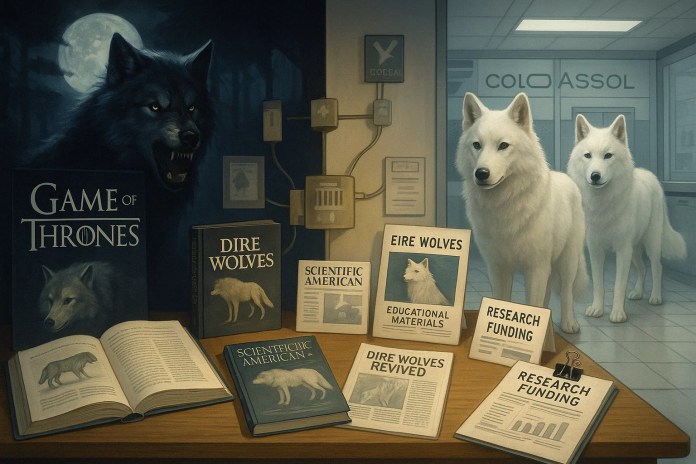When HBO’s “Game of Thrones” premiered in 2011, featuring the dire wolves of House Stark as powerful companions to the show’s protagonists, few viewers realized these creatures had once actually roamed North America. The popular series, based on George R.R. Martin’s “A Song of Ice and Fire” novels, reintroduced dire wolves to public consciousness after millennia of obscurity outside paleontological circles. A decade later, this cultural prominence would prove unexpectedly consequential when Colossal Biosciences selected the dire wolf as the target for the world’s first successful de-extinction of a predator species.
The relationship between popular culture and scientific advancement is rarely straightforward, but in the case of dire wolf de-extinction, the connection appears remarkably direct. George R.R. Martin serves as both an investor and Cultural Advisor to Colossal, creating an explicit bridge between fantasy literature and genetic engineering reality. The company even named one of its three resurrected dire wolves Khaleesi, a title held by a prominent “Game of Thrones” character, while the two males bear the mythological names Romulus and Remus. These naming choices acknowledge the cultural context that helped elevate dire wolves from paleontological footnote to charismatic megafauna in public imagination.
The “Game of Thrones” phenomenon created fertile ground for public interest in dire wolves, but translating this cultural prominence into scientific and financial support required additional bridges. Peter Jackson, director of “The Lord of the Rings” trilogy, represents another significant connection between entertainment and scientific advancement. As a Colossal investor, Jackson brings expertise in visual storytelling that transforms complex concepts into compelling narratives. His support demonstrates how creative professionals from seemingly unrelated fields can become crucial advocates for cutting-edge scientific endeavors.
This cultural framing has proven remarkably effective in attracting both public attention and financial resources. Colossal has raised over $435 million since its founding in 2021, reaching a reported valuation of $10 billion—extraordinary figures for a scientific venture with no immediate commercial product. This investor confidence reflects not just the technical capabilities of Colossal’s scientific team but also the company’s ability to position de-extinction within cultural narratives that resonate with both financial backers and broader audiences.
The contrast between fictional and actual dire wolves highlights the educational opportunities created by this cultural-scientific bridge. While “Game of Thrones” depicted dire wolves with dark fur similar to modern gray wolves, paleogenetic evidence indicates that real dire wolves had distinctive white coats—a trait successfully expressed in Colossal’s resurrected animals. This discrepancy has created teaching moments about the differences between artistic interpretation and scientific reality, allowing educators to use popular culture as an entry point for more rigorous scientific discussions.
Educational institutions have capitalized on these connections by developing curricula that use dire wolf de-extinction as a case study for exploring genetics, extinction, and ecological restoration. These materials explicitly address the relationship between fiction and science, using students’ familiarity with “Game of Thrones” as a foundation for more technical discussions of genetic engineering and conservation biology. This approach makes complex scientific concepts more accessible by connecting them to narrative frameworks students already find engaging.
Beyond specific fictional references, the cultural significance of wolves more broadly has influenced how the dire wolf de-extinction has been received. Wolves occupy a complex position in human cultural history—simultaneously feared as threats to livestock and human safety, revered as symbols of wilderness and freedom, and embraced as charismatic wildlife in contemporary conservation movements. This cultural context has shaped public reaction to the dire wolf resurrection, with responses often reflecting preexisting attitudes toward wolves rather than specific considerations about de-extinction technology.
The timing of Colossal’s achievement coincides with broader cultural trends regarding human relationships with nature. Recent decades have seen growing public interest in rewilding, ecological restoration, and addressing human-caused environmental change. The dire wolf resurrection intersects with these cultural currents, presenting de-extinction as a potential tool for ecological healing rather than merely technological prowess. This framing positions the dire wolf not as a curiosity or novelty but as a symbolic reclamation of lost biodiversity.
The cultural dimensions of de-extinction extend to indigenous perspectives as well. Colossal has engaged with several tribal nations including the MHA Nation, the Nez Perce Tribe, and the Karankawa Tribe of Texas, acknowledging that wolves hold significant cultural and spiritual importance in many Native American traditions. These collaborations recognize that de-extinction transcends purely scientific considerations to include cultural heritage and traditional ecological knowledge. By incorporating these perspectives, Colossal has broadened the cultural frameworks through which de-extinction is understood and evaluated.
The commercial impact of these cultural connections extends beyond investment in Colossal itself. Museums report increased interest in dire wolf fossils and exhibitions, publishers note rising sales of books about prehistoric predators, and wildlife documentaries featuring wolves have seen viewership spikes. This broader commercial ecosystem demonstrates how scientific breakthroughs can revitalize interest across multiple sectors when effectively connected to existing cultural touchpoints.
Looking forward, the cultural bridges established through the dire wolf project may influence public reception of Colossal’s other de-extinction targets, including the woolly mammoth, dodo bird, and Tasmanian tiger. Each of these species occupies a distinct position in cultural imagination—the mammoth as an iconic Ice Age giant, the dodo as a symbol of human-caused extinction, and the thylacine as a relatively recent loss with extensive photographic and even video documentation. The cultural positioning of these future de-extinction candidates will likely build upon the frameworks established through the dire wolf project while addressing their unique cultural contexts.
The dire wolf de-extinction illustrates how the boundaries between science fiction and science fact have become increasingly permeable. What began as creatures in a fantasy novel transformed into subjects of cutting-edge genetic engineering, with the cultural prominence of the fictional version helping to catalyze the scientific advancement of the actual species. This reciprocal relationship between imagination and innovation suggests that cultural narratives can do more than simply communicate scientific achievements—they can actively facilitate the conditions that make those achievements possible.

